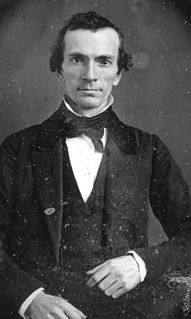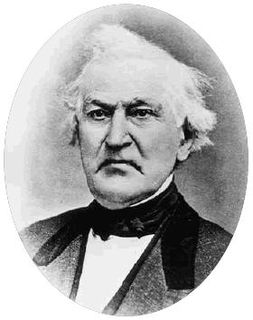
The Book of Mormon is a religious text of the Latter Day Saint movement, which, according to Latter Day Saint theology, contains writings of ancient prophets who lived on the American continent from 600 BC to AD 421 and during an interlude dated by the text to the unspecified time of the Tower of Babel. It was first published in March 1830 by Joseph Smith as The Book of Mormon: An Account Written by the Hand of Mormon upon Plates Taken from the Plates of Nephi. The Book of Mormon is one of the standard works of the Latter Day Saint movement and one of the movement's earliest unique writings. The denominations of the Latter Day Saint movement typically regard the text primarily as scripture and secondarily as a record of God's dealings with ancient inhabitants of the Americas. The majority of Latter Day Saints believe the book to be a record of real-world history, with Latter Day Saint denominations viewing it variously as an inspired record of scripture to the lynchpin or "keystone" of their religion. Some Latter Day Saint academics and apologetic organizations strive to affirm the book as historically authentic through their scholarship and research, but mainstream archaeological, historical, and scientific communities have discovered little to support the existence of Book of Mormon civilizations, and do not consider the Book of Mormon to be a record of historical events.

James Robert White is a Baptist theologian, the director of Alpha and Omega Ministries, an evangelical Reformed Baptist Christian apologetics organization based in Phoenix, Arizona and a Christian scholar. He is the author of several books.

According to Latter Day Saint belief, the golden plates are the source from which Joseph Smith translated the Book of Mormon, a sacred text of the faith. Some witnesses described the plates as weighing from 30 to 60 pounds, gold in color, and composed of thin metallic pages engraved with hieroglyphics on both sides and bound with three D-shaped rings.

Oliver H. P. Cowdery was an American Mormon leader who, with Joseph Smith, was an important participant in the formative period of the Latter Day Saint movement between 1829 and 1836. He was the first baptized Latter Day Saint, one of the Three Witnesses of the Book of Mormon's golden plates, one of the first Latter Day Saint apostles, and the Second Elder of the church.

Since the publication of the Book of Mormon in 1830, Mormon archaeologists have attempted to find archaeological evidence to support it. Although historians and archaeologists consider the book to be an anachronistic invention of Joseph Smith, many members of The Church of Jesus Christ of Latter-day Saints and other denominations of the Latter Day Saint movement believe that it describes ancient historical events in the Americas.

According to most adherents of the Latter Day Saint movement, the Book of Mormon is a 19th-century translation of a record of ancient inhabitants of the American continent, which was written in a script which the book refers to as "reformed Egyptian". This claim, as well as all claims to historical authenticity of the Book of Mormon, are rejected by non-Latter Day Saint historians and scientists. Linguistically based assertions are frequently cited and discussed in the context of the subject of the Book of Mormon, both in favor of and against the book's claimed origins.

Cumorah is a drumlin in Palmyra, New York, United States, where Joseph Smith said he found a set of golden plates which he translated into English and published as the Book of Mormon.

David Whitmer was an American Mormon leader who eventually became the most interviewed of the Three Witnesses to the Book of Mormon's golden plates.
Dennis Michael Quinn was an American historian who focused on the history of The Church of Jesus Christ of Latter-day Saints. He was a professor at Brigham Young University (BYU) from 1976 until he resigned in 1988. At the time, his work concerned church involvement with plural marriage after the 1890 Manifesto, when new polygamous marriages were officially prohibited. He was excommunicated from the church as one of the September Six and afterwards was openly gay. Quinn nevertheless identified as a Latter-day Saint and continued to believe in many LDS teachings, though he did not actively practice the faith.

Signature Books is an American press specializing in subjects related to Utah, Mormonism, and Western Americana. The company was founded in 1980 by George D. Smith and Scott Kenney and is based in Salt Lake City, Utah. It is majority owned by the Smith-Pettit Foundation.

View of the Hebrews is an 1823 book written by Ethan Smith, a Congregationalist minister in Vermont, who argued that Native Americans were descended from the Ten Lost Tribes of Israel, a relatively common view during the early nineteenth century. Numerous commentators on Mormon history, from LDS Church general authority B. H. Roberts to Fawn M. Brodie, biographer of Joseph Smith, have noted similarities in the content of View of the Hebrews and the Book of Mormon, which was first published in 1830, seven years after Ethan Smith's book.

Studies of the Book of Mormon is a collection of essays written at the beginning of the 20th century by B. H. Roberts (1857–1933), a general authority of The Church of Jesus Christ of Latter-day Saints, which examine the validity of the Book of Mormon as a translation of an ancient American source.

The Spalding–Rigdon theory of Book of Mormon authorship is the theory that the Book of Mormon was plagiarized in part from an unpublished manuscript written by Solomon Spalding. The theory first appeared in print in the book Mormonism Unvailed [sic], published in 1834 by E. D. Howe. The theory is that a Spalding manuscript was stolen by Sidney Rigdon, who used it in collusion with Joseph Smith and Oliver Cowdery to produce the Book of Mormon. Although Rigdon claimed that he was converted to the Latter Day Saint movement through reading the Book of Mormon, Howe argued that this story was a later invention to cover the book's true origins.

In the Latter Day Saint movement, the term Urim and Thummim (;) refers to a descriptive category of instruments used for receiving revelation or translating languages. According to Latter Day Saint theology, the two stones found in the breastplate of Aaron in the Old Testament, the white stone referenced in the Book of Revelation in the New Testament, the two stones bound by silver bows into a set of spectacles (interpreters) that movement founder Joseph Smith said he found buried in the hill Cumorah with the golden plates, and the seer stone found while digging a well used to translate the Book of Mormon are all examples of Urim and Thummim. Latter Day Saint scripture states that the place where God resides is a Urim and Thummim, and the earth itself will one day become sanctified and a Urim and Thummim, and that all adherents who are saved in the highest heaven will receive their own Urim and Thummim.

Many members of the Latter Day Saint movement believe that the Book of Mormon is historically accurate. Most, but not all, Mormons hold the book's connection to ancient American history as an article of their faith. This view finds no acceptance outside of Mormonism in the broader scientific community. Mainstream archaeological, historical, and scientific communities do not consider the Book of Mormon an ancient record of actual historical events.

There are several explanations as to the origin of the Book of Mormon. Adherents to the Latter Day Saint movement view the book as a work of divinely inspired scripture. Secular theories of authorship propose that it is solely the work of man.
The Wonders of Nature is a book by Josiah Priest that was published in 1826. The book starts off giving God the honor of creating everything with the main focus being on the incredible nature, which seen by the author, is controlled by God. The "wonders of nature," which include a number of examples of what are now termed cryptozoology and anomalistics, are concluded in the book to be proof that God lives and interferes. The author condemns people who deny the existence of God.

The standard works of Mormonism—the largest denomination of which is The Church of Jesus Christ of Latter-day Saints —have been the subject of various criticisms. Latter-day Saints believe the Book of Mormon is a sacred text with the same divine authority as the Bible; both are considered complementary to each other. Other Mormon sacred texts include the Pearl of Great Price and Doctrine and Covenants, which are also recognized as scripture. Religious and scholarly critics outside Mormonism have disputed Mormonism's unique scriptures, questioning the traditional narrative of how these books came to light and the extent to which they describe actual events. Critics cite research in history, archeology, and other disciplines to support their contentions.

The origins, authenticity, and historicity of the Book of Mormon have been subject to considerable criticism from scholars and skeptics since it was first published in 1830. The Book of Mormon is a sacred text of the Latter Day Saint movement, which adherents believe contains writings of ancient prophets who lived on the American continent from approximately 2200 BC to AD 421. It was first published in March 1830 by Joseph Smith as The Book of Mormon: An Account Written by the Hand of Mormon upon Plates Taken from the Plates of Nephi, who said that it had been written in otherwise unknown characters referred to as "reformed Egyptian" engraved on golden plates that he personally transcribed. Contemporary followers of the Latter Day Saint movement typically regard the text primarily as scripture, but also as a historical record of God's dealings with the ancient inhabitants of the Americas.
This is a bibliography of works on the Latter Day Saint movement.










